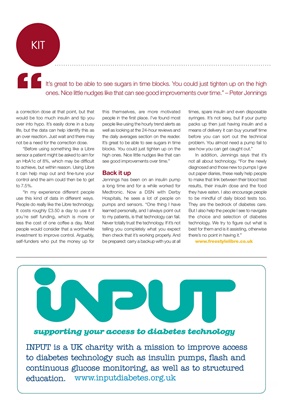
KIT
a correction dose at that point, but that
would be too much insulin and tip you
over into hypo. It's easily done in a busy
life, but the data can help identify this as
an over reaction. Just wait and there may
not be a need for the correction dose.
"Before using something like a Libre
sensor a patient might be asked to aim for
an HbA1c of 8%, which may be difficult
to achieve, but within reason. Using Libre
it can help map out and fine-tune your
control and the aim could then be to get
to 7.5%.
"In my experience different people
use this kind of data in different ways.
People do really like the Libre technology.
It costs roughly £3.50 a day to use it if
you're self funding, which is more or
less the cost of one coffee a day. Most
people would consider that a worthwhile
investment to improve control. Arguably,
self-funders who put the money up for
this themselves, are more motivated
people in the first place. I've found most
people like using the hourly trend alerts as
well as looking at the 24-hour reviews and
the daily averages section on the reader.
It's great to be able to see sugars in time
blocks. You could just tighten up on the
high ones. Nice little nudges like that can
see good improvements over time."
Back it up
Jennings has been on an insulin pump
a long time and for a while worked for
Medtronic. Now a DSN with Derby
Hospitals, he sees a lot of people on
pumps and sensors. "One thing I have
learned personally, and I always point out
to my patients, is that technology can fail.
Never totally trust the technology. If it's not
telling you completely what you expect
then check that it's working properly. And
be prepared: carry a backup with you at all
It's great to be able to see sugars in time blocks. You could just tighten up on the high
ones. Nice little nudges like that can see good improvements over time." - Peter Jennings
" times, spare insulin and even disposable
syringes. It's not sexy, but if your pump
packs up then just having insulin and a
means of delivery it can buy yourself time
before you can sort out the technical
problem. You almost need a pump fail to
see how you can get caught out."
In addition, Jennings says that it's
not all about technology. "For the newly
diagnosed and those new to pumps I give
out paper diaries, these really help people
to make that link between their blood test
results, their insulin dose and the food
they have eaten. I also encourage people
to be mindful of daily blood tests too.
They are the bedrock of diabetes care.
But I also help the people I see to navigate
the choice and selection of diabetes
technology. We try to figure out what is
best for them and is it assisting, otherwise
there's no point in having it."
www.freestylelibre.co.uk
INPUT is a UK charity with a mission to improve access
to diabetes technology such as insulin pumps, flash and
continuous glucose monitoring, as well as to structured
education. www.inputdiabetes.org.uk